
The Church, especially the Church in Rome, is in an objectively dreadful state.
For the sake of the Roman Church, let us today invoke St. Agnes, virgin and martyr.
O glorious Agnes who, though weak, was chosen by God to make His own might manifest in your martyrdom, together with the Peter and Paul and the other Roman martyrs and confessors, intercede now before the throne of our Christ the High Priest in heaven and beg a return of orthodoxy, sanity and sanctity to the Church especially in Rome and in particular the Roman Curia at every level. O holy Agnes, who bravely suffered torments, ask Mary, the Queen of the Clergy, to protect and aid all priests, so that they will all stand up boldly and teach the truth about the Sacrament of Matrimony, the integrity of the Sacrament of Holy Orders, the truth about the Most Holy Eucharist, and beg for the restoration and renewal of our sacred liturgical worship of the Lamb who was slain. We entrust this to you, blessed Saint Agnes, with all our confidence. Amen.
I have posted the following in times past, but it bears repetition. Newcomers to this blog may not have seen it.
Behold the skull of Agnes, in situ, in her beautiful church in Rome on the Piazza Navona.
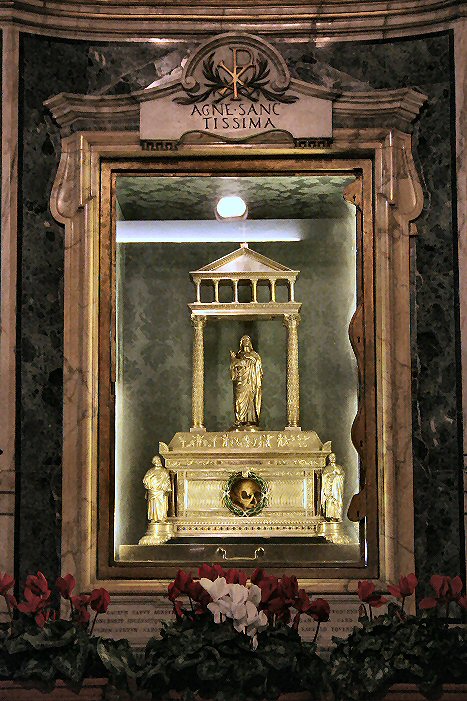
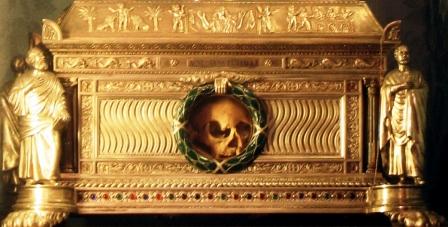
The dies natalis (“birthday into heaven”) of Agnes was recorded in the register of the depositio martyrum as 21 January.
St. Agnes was slain probably during the reign of the Emperor Diocletian in 304. Some say she died during the time of the Emperor Valerian (+260).
The little girl was buried by her parents in praediolo suo, on their property along the Via Nomentana where there was already a cemetery.
This cemetery expanded rapidly after that, because many wanted to be buried near the grave of the famous martyr. The ancient cemetery grew in stages between the Basilica which Constantina, daughter of Constantine and Fausta began over her tomb from 337-350 and the small round Basilica of Constantia (Constantine’s daughter).
There was an acrostic inscription from that time in verses about the dedication of the temple to Agnes:
Constantina deum venerans Christoque dicata
Omnibus impensis devota mente paratis
Numine divino multum Christoque iuvante
Sacravit templum victricis virginis Agnes…
You get the idea.
The Basilica of St. Agnes was reconstructed towards the end of the 5th c. by Pope Symmachus (+514). Honorius I (+638) rebuilt it as a basilica with three naves, adding a wonderful fresco of Agnes. It was worked on again in the 16th c. by St. Pius V and in the 19th by Bl. Pope Pius IX.
Excavations in 1901 uncovered the silver sarcophagus made by Pius V for St. Agnes together with St. Emerentiana.
It contained the headless body of a young girl.
 Zadock gave us a photo of the miraculous protection of Bl. Pius IX when once at the Basilica there was a near disastrous cave-in/collapse and no one was injured.
Zadock gave us a photo of the miraculous protection of Bl. Pius IX when once at the Basilica there was a near disastrous cave-in/collapse and no one was injured.
While Agnes’s body is in her tomb on the Via Nomentana, her skull is now at the place of her supposed martyrdom at the Piazza Navona in Rome’s heart. It is a fitting place to venerate a saint so much in the heart of the Roman people even today. It is not unusual for people today to name their children Agnes in honor of this great virgin martyr, whose name is pronounced in the Roman Canon.
The skull was bequeathed to that church at the Piazza by Pope Leo XIII who took it from the treasury of the Sancta Sanctorum.
The Piazza itself was in ancient times the Stadium of Domitian (+96) a place of terror and blood for early Christians, far more than the Colosseum ever was. The Piazza is thus called also the “Circo Agonale” and the name of the saint’s church is Sant’Agnese in Agone. “Navona” is a corruption of “Agonale”, from Greek agon referring to the athletic contests of the ancient world. St. Paul used the athlete’s struggle as an image of the Christian life of suffering, perseverance, and final victory even through the shedding of blood. Early Christian tombs often have wavy lines carved on the front, representing an metal instrument called a strigil, used by athletes to scrape dirt and oil from their bodies after contests. Victory palm branches are still used in the iconography of saints, as well as wreathes of laurels.
We know about St. Agnes from St. Jerome, and especially St. Augustine’s Sermons 273, 286 and 354. St. Ambrose wrote about Agnes in de virginibus 1,2,5-9 written in 377 as did Prudentius in Hymn 14 of the Peristephanon written in 405.
Ambrose has a wonderful hymn about Agnes (no. 8), used now in the Roman Church for Lauds and Vespers of her feast. The Ambrosian account differs somewhat from others. For Ambrose, Agnes died from beheading. Prudentius has her first exposed to shame in a brothel and then beheaded.
Here is the text of the hymn from the Liturgia horarum for the “Office of Readings” with a brutally literal translation.
Igne divini radians amoris
corporis sexum superavit Agnes,
et super carnem potuere carnis
claustra pudicae.
Shining with the fire of divine love
Agnes overcame the gender of her body,
and the undefiled enclosures of the flesh
prevailed over flesh.
Spiritum celsae capiunt cohortes
candidum, caeli super astra tollunt;
iungitur Sponsi thalamis pudica
sponsa beatis.
The heavenly host took up her brilliant white spirit,
and the heavens lifted it above the stars;
the chaste bride is united to the
blessed bride chambers of the Spouse.
Virgo, nunc nostrae miserere sortis
et, tuum quisquis celebrat tropaeum,
impetret sibi veniam reatus
atque salutem.
O virgin, now have pity on our lot,
and, whoever celebrates your victory day,
let him earnestly pray for forgiveness of guilt
and salvation for himself.
Redde pacatum populo precanti
principem caeli dominumque terrae
donet ut pacem pius et quietae
tempora vitae.
Give back to this praying people
the Prince of heaven and Lord of the earth,
that he, merciful, may grant us peace
and times of tranquil living.
Laudibus mitem celebremus Agnum,
casta quem sponsum sibi legit Agnes,
astra qui caeli moderatur atque
cuncta gubernat. Amen.
Let us celebrate with praises the gentle Lamb,
whom chaste Agnes binds to herself as Spouse,
he who governs the stars of heaven
and guides all things. Amen.
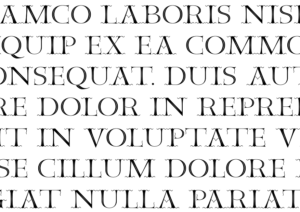 We can note a couple things from this prayer. First, the reference to fire probably a description of Agnes’s death related in a metrical panegyric of Pope Damasus about how Agnes endured martyrdom by fire. On the other hand, St. Ambrose, when speaking of her death, speaks of martyrdom by the sword.
We can note a couple things from this prayer. First, the reference to fire probably a description of Agnes’s death related in a metrical panegyric of Pope Damasus about how Agnes endured martyrdom by fire. On the other hand, St. Ambrose, when speaking of her death, speaks of martyrdom by the sword.
Pope St. Damasus composed a panegyric, an elogia, inscribed in gorgeous letters on marble (designed and executed by Dionysius Philocalus) in honor of Roman saints, including Agnes. This was the period when the Roman liturgy shifted from Greek to stylized (not common or everyday “vernacular”) Latin. Damasus was also trying to make a social statement with these great inscriptions, set up at various places about the City. The panegyric of St. Agnes was placed in the cemetery near the saint’s tomb, but through the ages it was lost. Amazingly, it was at last rediscovered in 1728 inside the basilica, whole and complete: it had been used as a paving stone! Fortunately, upside down! Its rediscovery was a find of vast importance.
Now it is affixed to the wall in the corridor descending to the narthex.
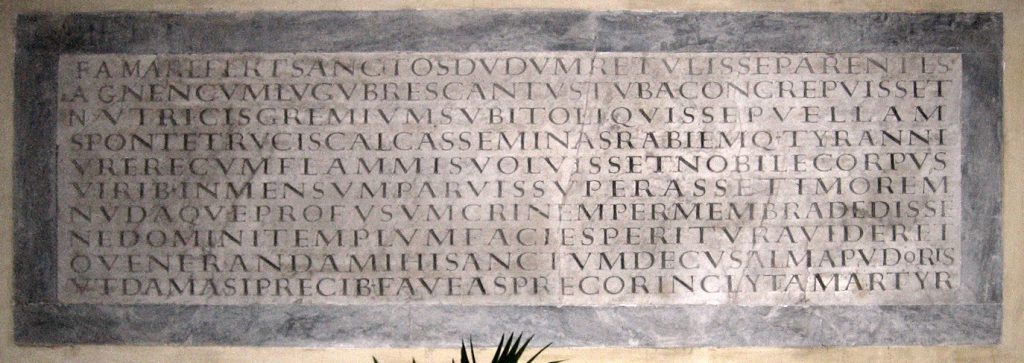
FAMA REFERT SANCTOS DUDUM RETULISSE PARENTES
AGNEN CUM LUGUBRES CANTUS TUBA CONCREPUISSET
NUTRICIS GREMIUM SUBITO LIQUISSE PUELLAM
SPONTE TRUCIS CALCASSE MINAS RABIEMQUE TYRANNI
URERE CUM FLAMMIS VOLUISSET NOBILE CORPUS
VIRIBUS INMENSUM PARVIS SUPERASSE TIMOREM
NUDAQUE PROFUSUM CRINEM PER MEMBRA DEDISSE
NE DOMINI TEMPLUM FACIES PERITURA VIDERET
O VENERANDA MIHI SANCTUM DECUS ALMA PUDORIS
UT DAMASI PRECIBUS FAVEAS PRECOR INCLYTA MARTYRIt is told that one day the holy parents recounted that Agnes, when the trumpet had sounded its sad tunes, suddenly left the lap of her nurse while still a little girl and willingly trod upon the rage and the threats of the cruel tyrant. Though he desired to burn the noble body in the flames, with her little forces she overcame immense fear and, gave her loosened hair to cover her naked limbs, lest mortal eye might see the temple of the Lord. O one worthy of my veneration, holy glory of modesty, I pray you, O illustrious martyr, deign to give ear to the prayers of Damasus.
Damasus used the sources available. There were the stories told by her parents, the 4th edict of Diocletian against Christians in 304 (lugubres cantus tuba concrepuisset). Agnes did what she did of her own free will (sponte). Note the reference to the body as temple of God (1 Cor 3:16 and 2 Cor 6:16).
St. Agnes of Rome, has two grand churches in Rome. She has two feast days in the traditional Roman calendar.
Since the reform of the calendar, Agnes now has only one day, alas.
Ask Agnes to intercede with God for a return of sanity to the Roman Church.
Also, here is a shot of my 1st class relic of St. Agnes. Thank you to the kind reader – Susan – who sent me the reliquary back in May 2020.
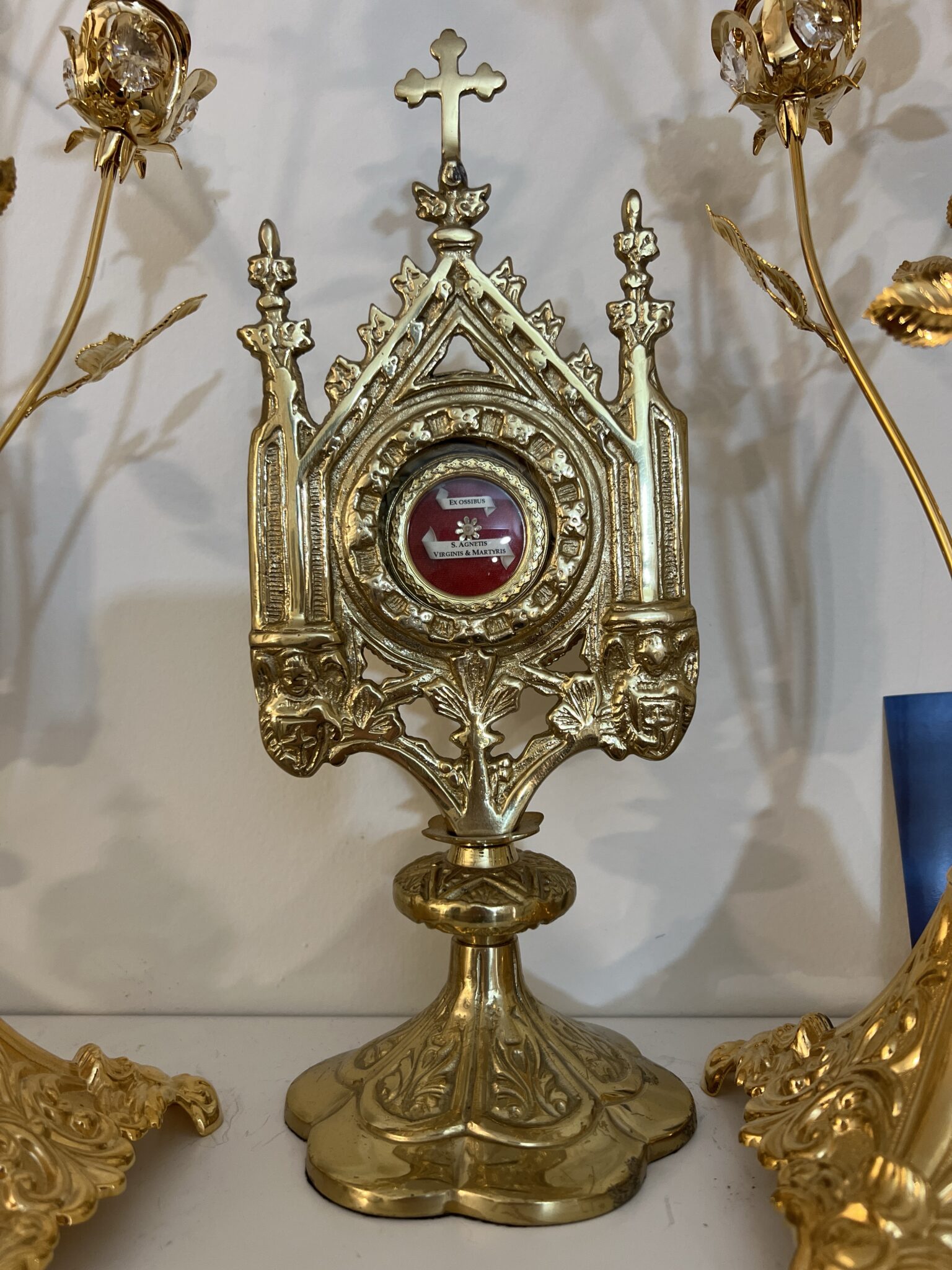
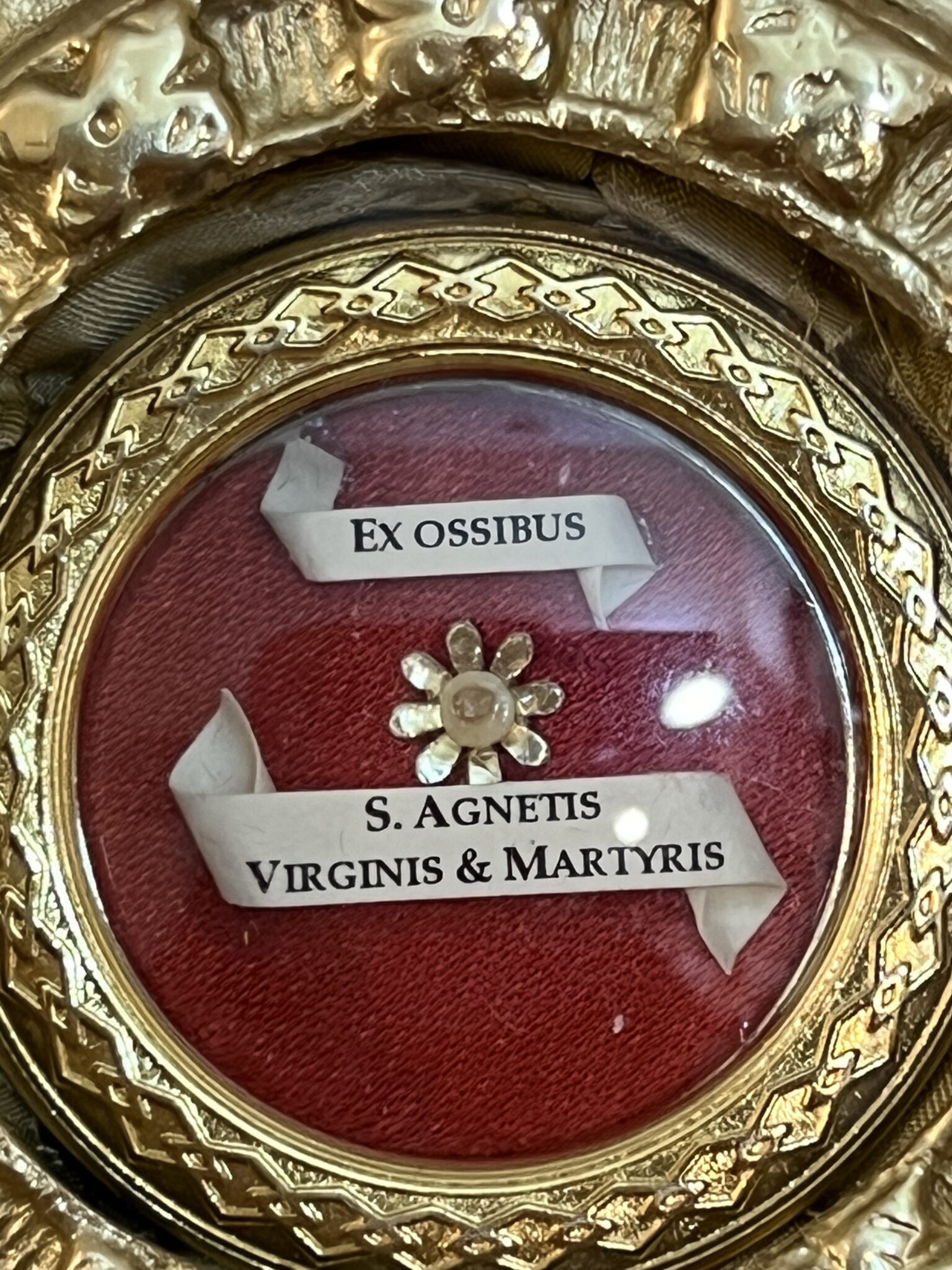


































Thank you for this Fr. Z.
I asked for this in the morning and glory be you read my mind.
Thank you for telling us about St. Agnes.
Father, I truly enjoyed reading everything about St. Agnes. It took me back so many years to my childhood and all the little books about saints’ lives that I loved to read. We definitely need their witness and inspiration these days. Come Lord Jesus!
Thank you, Fr. Z!
This was very interesting. The “paving stone” story really makes you wonder at the numbskulls of history.